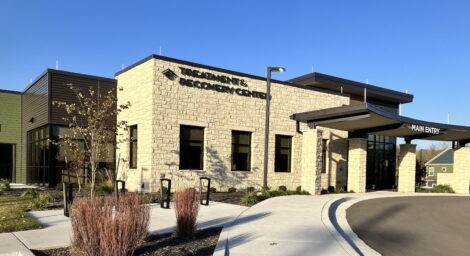Douglas County Commission approves long-awaited lease and operating agreement for crisis center; Bert Nash will run it

photo by: Kim Callahan/Journal-World
The Treatment and Recovery Center of Douglas County is pictured on Saturday, Oct. 22, 2022.
Story updated at 8:49 p.m. Wednesday, April 5:
By this time next week, the long wait for the doors to Douglas County’s behavioral health crisis center to open could finally be over.
The Douglas County Commission voted Wednesday night to approve a lease and operating agreement with Bert Nash Community Mental Health Center for the Treatment and Recovery Center of Douglas County, 1000 W. Second St. The lease is effective as of Thursday, April 6, at 12:01 a.m. and remains in effect until April 5, 2028. The operating agreement was approved at a cost not to exceed $1.6 million in county-supported funding in 2023.
All three county commissioners expressed gratitude for the work it’s taken to get to this point on a negotiation timeline county staff warned would be incredibly rapid back in February.
“This has been a long time coming,” Commissioner Patrick Kelly said shortly before the commission’s vote. “There have been a lot of tough conversations, and we should be proud as a community that we can have tough conversations, that we can grow from tough conversations, that we can make something stronger and better by being in a place that’s uncomfortable.”
The operating agreement wasn’t finalized until Wednesday afternoon, Douglas County Administrator Sarah Plinsky said, meaning commissioners hadn’t yet gotten a chance to review it in its final form before the start of the commission meeting that evening. Commissioners met in a 20-minute executive session before any details were shared with the public.
The operating agreement’s initial term runs through the end of this year, then for a presumptive one-year term for 2024 and successive one-year terms in each subsequent year, subject to renewal by the County Commission.
The lease, meanwhile, was reviewed in time to be included as an attachment with this week’s agenda. Under the lease terms, Bert Nash is defined as the tenant and the county is defined as the landlord. Bert Nash will be paying $70,000 per month in rent for the first year, a cost that will then increase by 2% over the rent for the immediately preceding year through the remaining four years of the contract.
With the facility checking in at 20,000 square feet, that means the rental cost for the first year of the agreement is equivalent to $42 per square foot.
“A lot of work has gone into the last several months, and it’s really accelerated the last few days to meet the aggressive timeline … to finish our work and be ready to open up the Treatment and Recovery Center,” Plinsky told commissioners Wednesday night.
Commissioners Karen Willey and Shannon Reid both expressed some concern about making sure that folks in the public will be able to see the full operating agreement document, and county staff assured them that the document would be made available as soon as possible following the commission’s vote.
• • •
Leaders didn’t specify an opening date at Wednesday’s meeting, but a tentative opening timeline was laid out at a commission meeting in late March, and the timeline was shown again on Wednesday. That timeline lists April 10 — next Monday — as the target date for when the facility will begin partial operations through its front-of-house urgent care unit.
That part of the facility will accept community walk-ins on weekdays from 8 a.m. to 8 p.m. and on weekends from noon to 4 p.m. year-round. Services available from the start will include triage assessments, psychiatric medical evaluations and prescriptions, referrals to other providers, initial treatment planning and care coordination. Folks who visit the urgent care unit will also be able to schedule and return for follow-up appointments as needed.
The target date for the other part of the facility, its observation and stabilization unit for patients who need to stay for 23 to 72 hours, is about a month and a half later, on May 25. Starting with a maximum capacity of 10 patients, that portion of the building will be where referrals from LMH Health, Bert Nash’s mobile response team and area first responders will be dropped off. Initially, those folks will be voluntary referrals, people who give their consent to be admitted for treatment.
Caps on the observation and stabilization unit’s patient capacity will tentatively increase to 16 patients in mid-July and 24 patients in early October, according to the timeline, coinciding with when the facility can expect to be ready for any involuntary referrals coming from first responder and health care partners. The county’s director of behavioral health projects, Bob Tryanski, told commissioners in March that those numbers and dates could be subject to change depending on actual patient volumes after the facility begins operating, though.
Along the way, Bert Nash plans to track some key performance indicators, such as the progress of hiring for positions at the facility and turnaround times for serving patients. Tryanski showed the spreadsheets the county and Bert Nash are using to track those milestones during Wednesday’s presentation.
Tryanski and Plinsky also gave commissioners a rough idea of the TRC’s 2023 and 2024 budgets. Plinsky said the facility’s estimated expenses for 2023 should be just over $8.8 million. For 2024, Plinsky said the total estimated expenses are higher at $10.4 million to account for the full year, with an estimated funding contribution of $2.8 million from the county.
Plinsky added that the county and Bert Nash are also anticipating an influx of additional funding for the project — anywhere from $7.2 million to $7.7 million. Part of that comes from Bert Nash’s status as a certified community behavioral health center, which means that it can receive more money for the services it provides, and some extra funding will also come from the Kansas Department for Aging and Disability Services.







